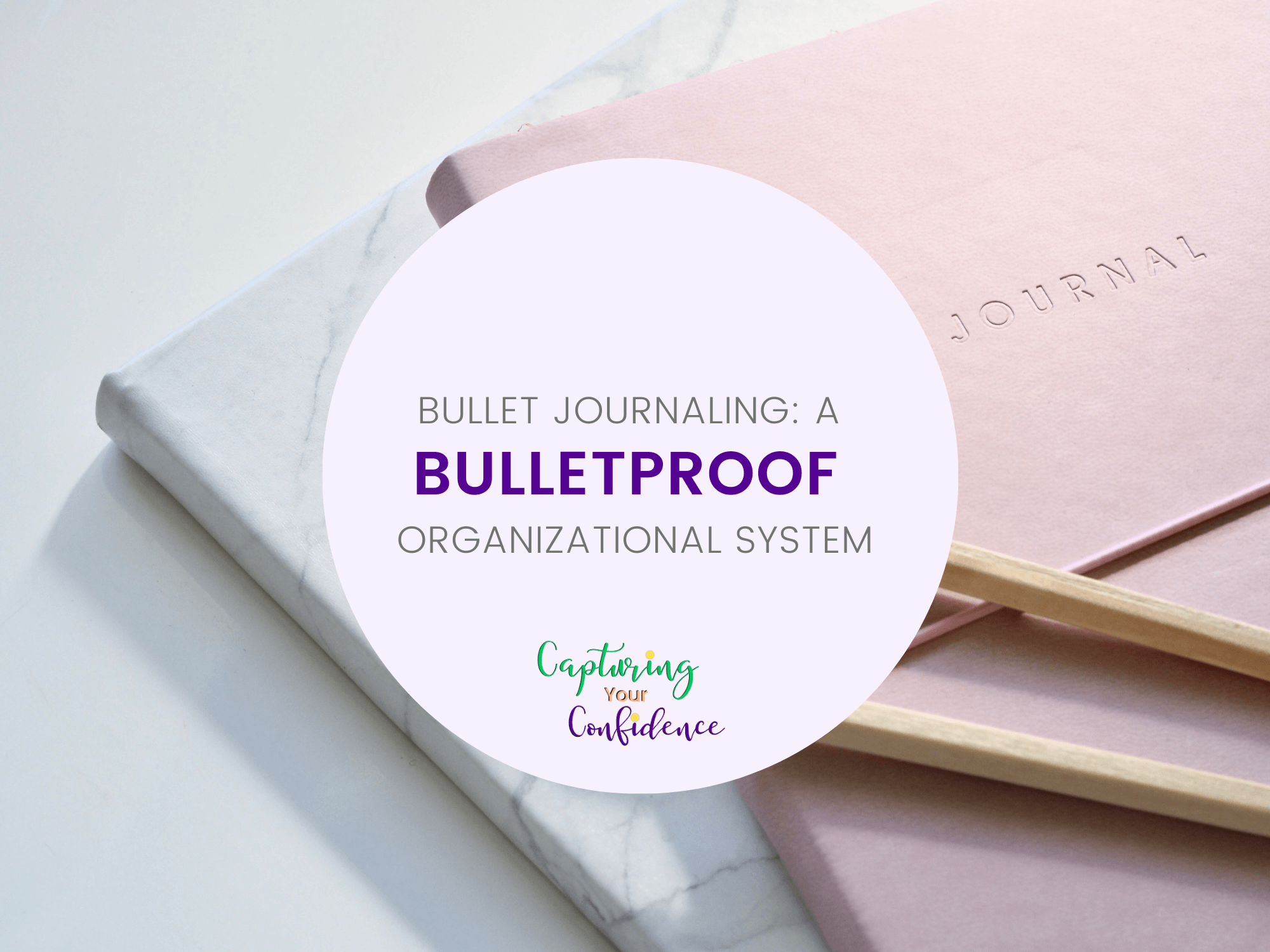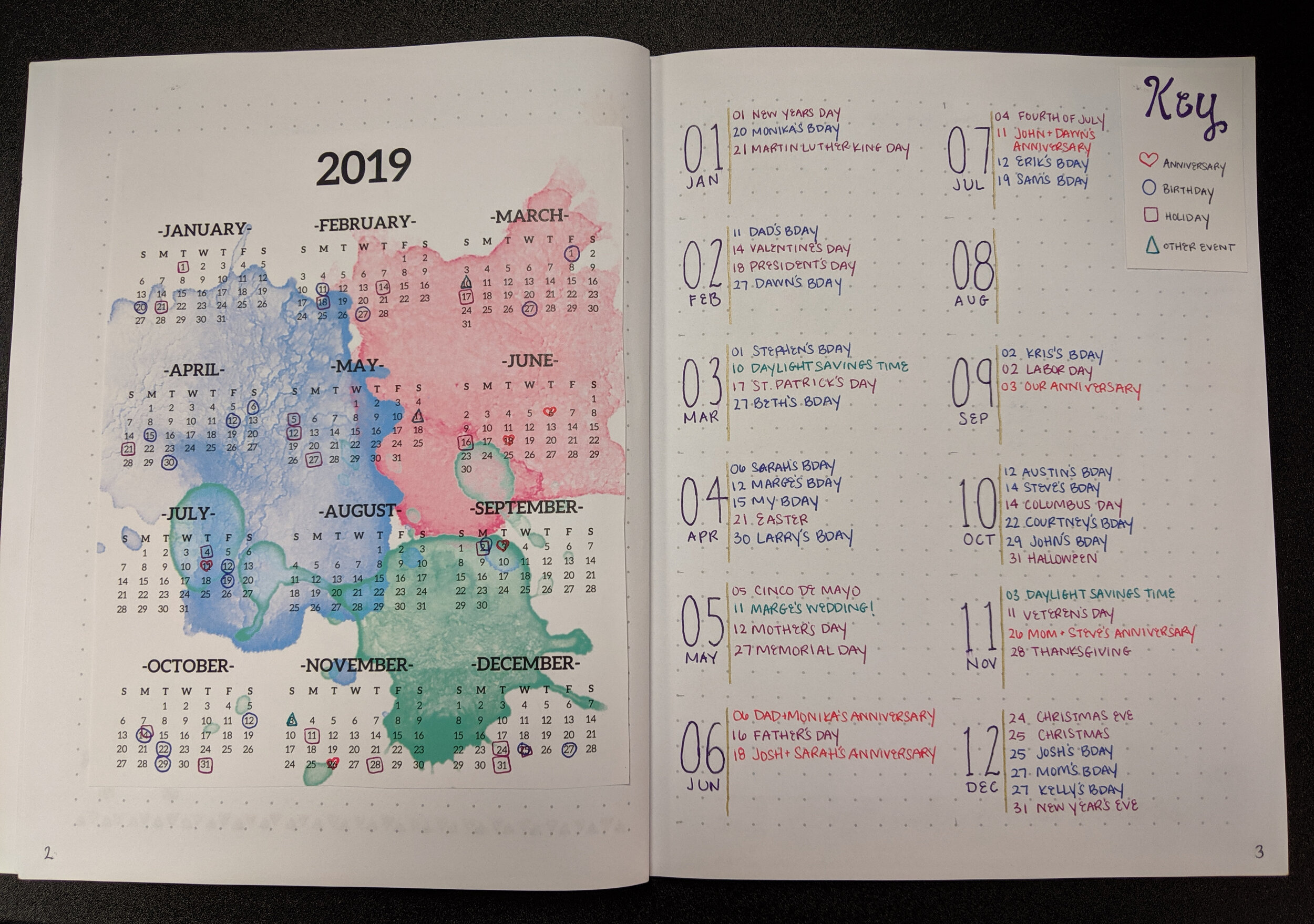Bullet Journaling: A Bulletproof Organizational System
Do you find yourself using multiple calendars? Having lists stuck to a Post-It note on the outside of your calendar? Forgetting your calendar at home when you need to schedule appointments? Or lost the calendar you finally remembered to write your shopping list in?
I have done all of those things and more. I LOVE lists, and that is not an exaggeration! And, I’ve come to accept that I love calendars, too. But not just any calendars. They have to meet a pretty strict set of standards:
Must be bigger than pocket-sized but smaller than a full page
Thick enough to not get bent in half in my bag, but small enough to fit in a large purse
Pages need to be more durable than the newsprint a lot of calendars use
Must include the full month and weekly view, but the weekly view has to be big enough for me to write down upcoming bills and appointments
Ideally not plain: I like my calendars to look cute or inspiring
Needs to have ample space for notes/lists
So you can see where I might run into trouble finding my ideal calendar, right?
Well, last year I found a great system that solves all of my calendar troubles! If you have any of the problems I mentioned before, like I did, this could be perfect for you, too.
The system I started last year is called a Bullet Journal. If you have never heard of this before, you can read about the “official” product and goals here on their website. If you have heard about this before and are skeptical, keep reading and I’ll show you how this creative organizational tool is not only incredibly helpful with daily life and planning, but also really helps me boost my creativity.
My Journey to the Journal
Before I started bullet journaling - which, despite what it sounds like, is not like a diary or anything (although you could definitely include pieces like that, if you want!) - I had a calendar called The Happy Planner. I loved this thing because it had space everywhere and it was so customizable! But, once I finished grad school, I didn’t need a huge calendar anymore.
So I shuffled around to a calendar from Barnes & Noble, which was okay but didn’t have enough space. And then I tried one from the dollar store and the pages were outright falling out, even though the space was great. So I Googled it and found the bullet journal method.
The idea is that you can put everything you need in one place - calendar, lists, goals, dreams, etc. - and utilize a simple system to keep yourself organized. You don’t even necessarily have to buy a new notebook to start, although dotted grid notebooks are far easier to work with, in my experience, because when you get more creative and draw lines or pictures, you don’t have to eyeball things (or if you love stickers, you don’t have to see them stuck on the page crooked every day.) Essentially the small, personalized details that make your bullet journal fun and your own.
The official branded Bullet Journal system was designed by Ryder Carroll, who has written a ton of great information about how to begin and structure, as well as a book. There are some key pieces that make up the structure of a bullet journal, although you can design them however you like. Each page or related topic is called a collection or spread. The pieces include:
The Index These are the pages at the front that tell you which collections are on which pages
The Future Log This spread is used for any longer term planning outside of the current month. Some people like to do 6 month planning. Personally, I like my future log to be the whole year at a glance.
The Monthly Log These pages plan each month with both a numbered calendar view & a task list.
The Daily Log These pages record your day-to-day activities & tasks.
Custom Collections Custom collections are anything that helps you stay organized, on task, or inspired! These are open to however or whatever you need them to be.
The example Carroll sets up is simple and easy to maintain, which is where I started before I developed the system that works best for me. If you’re using a calendar already, chances are that you already use most of the pieces of a bullet journal, they might just look and feel a little different. That’s good news, right?
After I learned how to do the basic formatting and key parts of the journal, I began to customize how I put it together.
Some of the pages in my bullet journal include:
Index (I like to leave 2-3 pages)
Entire year calendar at a glance (Future Log)
Each month with the month at a glance and each week with room to write on the days (Monthly Log & Daily Log)
Books to read
Year long goals
Home to do list for our house
Dreams for the backyard
Interview preparation
Giraffes (What can I say, I love them.)
Blog planning
Creative writing planning
I love giraffes so much that they are page #1 in my bullet journal!
And this isn’t even the whole list! But, this list is obviously super varied and the pages are not all related. Some pages, like my giraffe page, are pretty simple. I include them simply because they make me happy.
I do a lot of print-outs since I’m not good at the lettering by hand. I also plan one month in advance. So, last week, I set up my basic bones structure for July. This allowed me to fill in what I need to do in advance rather than having to come up with a whole new page each time an event comes up.
Outside of the calendar aspect, every time I have a new project or anything I need to make notes about, I turn to a new page of my bullet journal and it’s literally a blank canvas. When I’m done listing or brainstorming, or just doodling if that’s what I need, I got to my index and write it down so I can find it later.
“Well it’s cool that it works for you, Rachel, but is there a point to this?”
Yes! Bullet journaling is an incredibly powerful tool for writers and creators! Take a moment to think about how you organize your writing. Or your to do list when you need to get creative tasks accomplished. Do you have a good system? If so, that’s great! If not, this could be a quick and easy (and cheap) way to get yourself organized and actually feel good about it.
No matter how fancy Pinterest or Google examples are, bullet journals don’t need all that to function effectively. If you looked at the Youtube tutorial or read about Carroll’s system here, his is definitely not full of frills. Take a look at Carroll’s example:
https://www.youtube.com/watch?v=fm15cmYU0IM
Ryder Carroll sets up his original Bullet Journal formatting.
Personally, the original bullet journal seems a little utilitarian for me. But what do you do when you don’t have time to spend 3 hours handlettering one week of a month-long calendar? I know I don’t! I have found shortcuts and adaptations like print-outs and colored pens that spice things up but don’t take a long time to put together. Planning expert and blogger Erin Condren also shares some time saving tips in her blog.
Although all of it does require a bit more preparation than a calendar or planner you might buy at the store, front-loading some of that planning onto the beginning of the month or week (however you would use it best) will not end up being a bad thing in the long run, trust me. I use mine for everything. I have calendar sections, of course, because we have bills to pay and other obligations like everyone else; but, I also have whole blogging and creative writing sections.
I enjoy physically writing down my ideas, and of course, because I’m a list junkie, I like crossing things out on paper when they are complete. Free writing? Check. Plot map? You bet. Huge brainstorming list of future blogs? Absolutely. I also enjoy that I can get creative and colorful with colored pencils, pens, and even sometimes markers.
So How Do I Get On Board with This?
If you are visual and like videos, Youtube is full of helpful people who have posted how to get this going for themselves. I really enjoyed this super helpful and encouraging video by Natalies Outlet:
https://www.youtube.com/watch?v=BdCYG-hfGA8
How to Bullet Journal for Beginners! by Natalies Outlet
All you really need to start a bullet journal is a pen or other writing utensil, a notebook, and your imagination. And possibly Pinterest. Pinterest continues to inspire me!
You can get the notebooks from the Bullet Journal store directly or search Amazon. If you go to the Bullet Journal store, the notebooks are a little more expensive, but definitely high quality. There is a little bit less selection in terms of outward appearances, but they have built in features such as pointers for beginners and index pages that are already laid out for you.
I love the selection from Amazon because they have all different designs, page counts, and sizes. You can get a smaller notebook, like 5” x 7”, or you can go a little bigger and do 8” x 10” like I do. There are even notebooks that are normal paper size of 8.5” x 11” if you are so inclined. For me, I have my specific standards (those picky ones I mentioned at the beginning), so I stick pretty closely to the 8” x 10” notebooks and try to get as many pages as I can. I’m eyeing this little beauty for the end of this year when I run out of pages.
When you have your notebook, you are ready to start! If your notebook is completely blank, leave the first page or two blank. Those will be your index where you can easily reference what pages your content is on. If you already have the index pages, you can skip this step and get into the fun part! You’ll want to go through and number a good section of pages, though, as most blank notebooks don’t come with page numbers.
My 2019 Future Log/Full Year Spread
If you like some semblance of normalcy, you can start off with the future log first, which I do as a whole year at a glance calendar. Or not! Mine is on the second and third pages.
The rest is up to you and your needs. You can draw yourself a month calendar & weeks, print them out, brainstorm all over the page with your ideas, color code your characters for your writing...really, anything is possible! Kim Alvarez does a great job of going into depth with starting a bullet journal on her blog Tiny Ray of Sunshine, if you want a more detailed step-by-step guide and explanation.
What do you think? Is it worth trying out? If you are a fellow bullet journal enthusiast, what are your tips and tricks?
I’d love to hear your thoughts!




